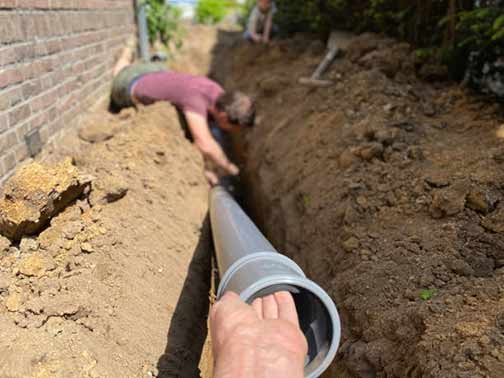
A sewer line belly is a lesser-known problem in underground drainage systems than clogs and blockages. However, Kokopelli Management says, it can be just as problematic as clogs and blockages. A sewer line belly is often the underlying cause of sewer line clogs or blockages.
What is a sewer line belly, what causes it, and how can you prevent it?
What is a sewer line belly?
A sewer line belly happens when a section of the sewer line sags or dips. Sewer lines are always installed to have some grade or slope throughout their length. It ensures that wastewater can flow through the line without difficulty under the force of gravity.
A sewer line belly is when a portion of the line sinks and goes out of grade. That alters the slope of the sewer line, resulting in misalignment that interferes with the flow of water. As a result, wastewater slows down in this section of the sewer line, letting debris settle inside the pipe.
Causes of a sewer line belly
The pipe is not properly sloped
Construction errors can lead to a sewer line being installed with the wrong slope. That predisposes it to clogs as water tends to settle within the line.
Improper soil bedding
Poor construction practices may also cause sewer line bellying. If the soil beneath a sewer line is not properly compacted, part of the line can collapse.
Environmental factors
Sinkholes, earthquakes, flooding, extreme temperature changes and soil erosion can lead to soil shifting, which in turn causes the sewer line to sag.
Aging pipes
Aging sewer lines can become unstable and likely to develop weak points that sag. That is common in sewer systems with metal pipes and older materials.
Sewer line leaks
A leak in one of the joints or connectors of the sewer line can cause sewer line bellies. If the soil around the leaking section is washed away, it will deny the pipe of its support.
Heavy loads
Placing heavy loads, such as large vehicles or machinery, on the ground directly above a sewer line can compress the soil and cause a part of the sewer line to dip.
Effects of a sewer line belly
Clogged and blocked drains
Typically, the first sign that your sewer line has formed a belly will be slow drains across the entire home, chronic drain clogs and similar issues.
Foul odors and unsanitary conditions
The accumulation of debris inside the sewer line will lead to foul odors inside the home and severe pest invasion of the property.
Sewer backup
The blockage in the sagged section of a sewer line can stop wastewater from flowing through and force it backwards into the home.
Foundation issues
If the sewer line belly happens in a location close to the foundation of the building, it could cause foundation failure and other kinds of structural damage.
Sewer line damage
A sewer line belly can eventually damage the sewer line. Stagnant water and sediment buildup in a sewer line may cause the pipes to crack and separate.
Property damage
A sewer line belly that is undetected and, therefore, left unattended can damage your landscaping, driveway, walkway and other structures on your property.
How to prevent sewer line bellies
Professional installation and proper sewer line maintenance are the only ways to protect your home from sewer line bellies.
Good construction practices
If the installer uses good materials, and ensures the correct slope and soil compaction, the risk of sewer line bellies is greatly reduced. Soil that is packed so tightly that there is no movement in it will not let the sewer line sag.
Avoid heavy loads weighing above the sewer line
The route of the sewer line across your yard should be marked, and heavy objects, such as vehicles or large construction equipment, should never be parked or driven over the location of the sewer line.
Be careful with landscaping projects
When doing a landscaping project on the property, great care must be taken to understand its potential impact on the sewer line. As much as possible, projects that will disturb the soil around the sewer line should be avoided.
Regular sewer line inspection
Although it will not prevent sewer line bellies, proper sewer line maintenance – with yearly sewer camera inspection – will help you catch the problem early. Early detection will let you minimize the damage caused by the problem in your sewer line.
Conclusion
To minimize or even eliminate the risk of a sewer line bellies in your drainage system, it is essential to hire experienced professionals when installing a sewer line.
Regular sewer system maintenance and inspection are also necessary because unexpected environmental issues can cause bellies to form in even a well-installed sewer line.


